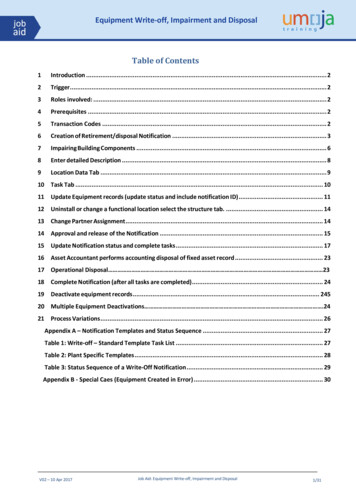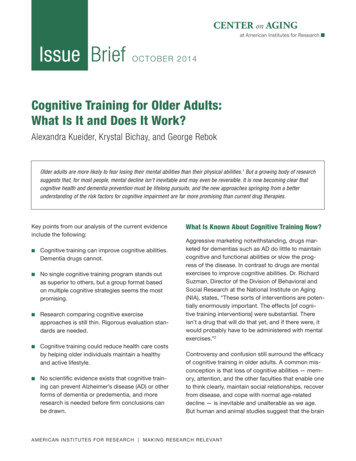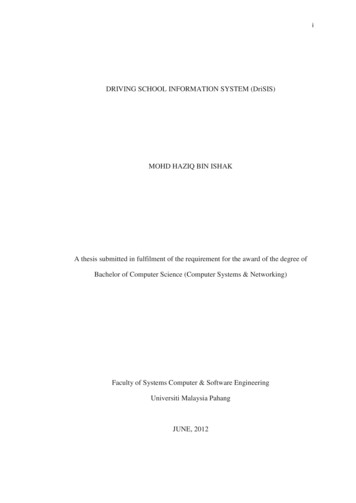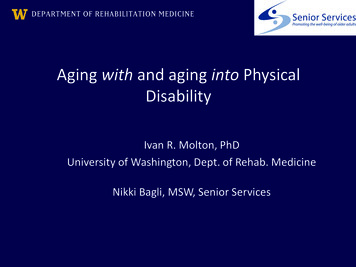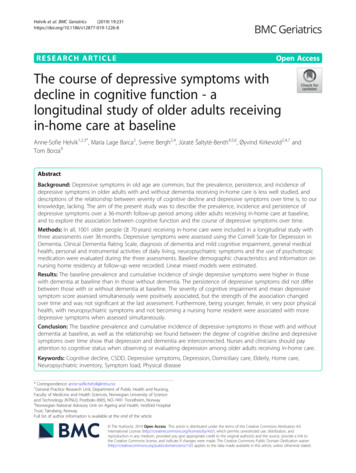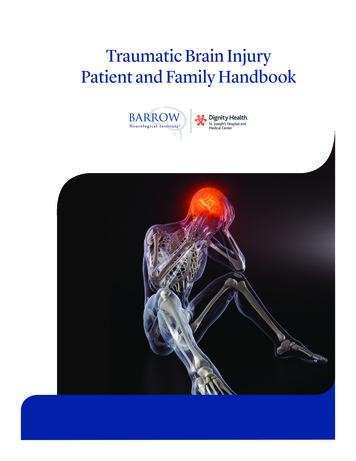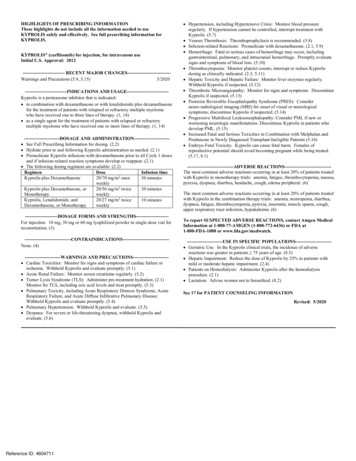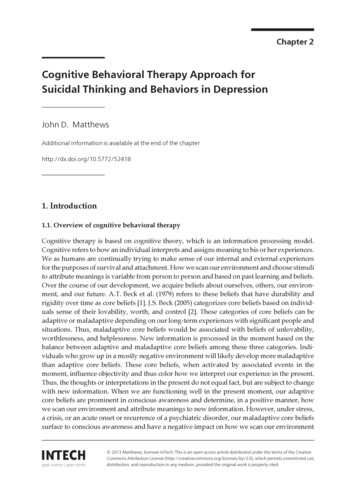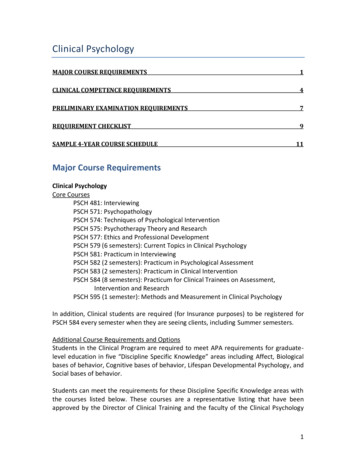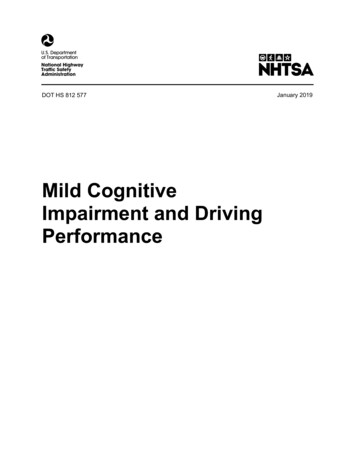
Transcription
DOT HS 812 577Mild CognitiveImpairment and DrivingPerformanceJanuary 2019
DisclaimerThis publication is distributed by the U.S. Department of Transportation,National Highway Traffic Safety Administration, in the interest ofinformation exchange. The opinions, findings, and conclusions expressedin this publication are those of the authors and not necessarily those ofthe Department of Transportation or the National Highway Traffic SafetyAdministration. The United States Government assumes no liability forits contents or use thereof. If trade or manufacturers’ names or productsare mentioned, it is because they are considered essential to the object ofthe publication and should not be construed as an endorsement. TheUnited States Government does not endorse products or manufacturers.Suggested APA Format Citation:Staplin, L., Lococo, K., Mastromatto, T., Gish, K. W., Golembiewski, G., & Sifrit, K. J. (2019, January).Mild cognitive impairment and driving performance (Report No. DOT HS 812 577). Washington,DC: National Highway Traffic Safety Administration.
Technical Report Documentation Page1. Report No.2. Government Accession No.DOT HS 812 5771. Title and SubtitleMild Cognitive Impairment and Driving Performance3. Recipient's Catalog No.5. Report DateJanuary 20196. Performing Organization Code7. AuthorsLoren Staplin,* Kathy Lococo,*Tia Mastromatto,* Kenneth W. Gish,*Gary Golembiewski,† and Kathy J. Sifrit‡8. Performing Organization Report No.9. Performing Organization Names and Addresses*TransAnalytics, LLC† Leidos, Inc.336 West Broad Street11951 Freedom DriveQuakertown, PA 18951Reston, VA 2019010. Work Unit No. (TRAIS)12. Sponsoring Agency Name and Address‡Office of Behavioral Safety ResearchNational Highway Traffic Safety Administration1200 New Jersey Avenue, SEWashington, DC 2059013. Type of Report and Period CoveredFinal Report11. Contract or Grant No.DTNH22-09-D-00135L,Task Order No. 0914. Sponsoring Agency Code15. Supplementary NotesDr. Kathy Sifrit was the NHTSA Task Order Manager on this project.16. AbstractThe objective of this project was to explore differences in driving performance and exposure between participants withmild cognitive impairment (MCI) – operationally defined through recognized clinical methods – and a comparisongroup of drivers of comparable age who did not meet those criteria. MCI refers to an intermediary, symptomatic statebetween age-appropriate cognitive decline and dementia. An initial literature review revealed a lack of clear boundariesbetween these cognitive status categories, which led researchers to consider continuous measures of cognitiveimpairment to predict road test performance and exposure. Thirty-eight participants were recruited. Clinical measures,administered by a certified driver rehabilitation specialist (CDRS), included the trail-making and maze tests, plus theMontreal Cognitive Assessment (MoCA). The Functional Activities Questionnaire (FAQ) was used to obtainparticipants' self-reports indicating cognitive status. A CDRS also administered the road tests in two study locations (inand near Roanoke and Richmond, Virginia). Exposure data were recorded with GPS loggers and cameras installed inparticipants' own vehicles for approximately one month. Regression models identified MoCA scores, and to a lesserextent Maze Test scores, as significant predictors of road test results, particularly with respect to tactical driving tasks.There were no significant regression models for analyses of exposure measures. Analysis of impairment status (notimpaired, MCI, or moderate cognitive impairment) using only the MoCA classifications showed that those classified asunimpaired received significantly fewer points off on the on-road assessment than those classified as MCI, and thisdifference increased when comparing the unimpaired to those with any level of impairment. While the evidence wasmixed regarding the extent to which MCI drivers appropriately self-restrict their exposure, MoCA appears to be apractical tool for occupational therapist generalists to use in identifying referrals for a comprehensive drivingevaluation.17. Key Words18. Distribution Statementage, older, driver, performance, exposure, cognitive, impairmentDocument is available to the public from theNational Technical Information Service,www.ntis.gov.19. Security Classif. (of this report)Unclassified20. Security Classif.(of this page)UnclassifiedForm DOT F 1700.7 (8-72)21. No. of Pages22. Price72Reproduction of completed page authorizedi
AcknowledgementsThe efforts of John H. Vaughter, CDRS, and Janet T. Stohler, OTR/L, CDRS, were keyto the completion of this study. These professionals reached out to organizations in theircommunities to solicit research participants and performed the clinical and on-road assessmentsthat generated the data of primary interest for the planned analyses. Sandra Bell, in the office ofMs. Stohler, also provided essential support in completing informed consent procedures andother administrative responsibilities.The instrumentation of participants' vehicles with the exposure data collection systemused in this research was accomplished through the work of Patrick Spratt, who installed andremoved the systems from the private vehicles of consenting participants and performed systemtroubleshooting when necessary, often traveling great distances so participants could meet theserequirements of research participation in the convenience of their own homes.ii
Table of ContentsExecutive Summary . 1Background and Understanding of the Problem . 3Project Objective. 4Literature Review. 6Methods. 6Results . 6Driving Performance Study Methods . 10Participant Recruitment and Screening . 10In-Clinic Assessment . 12Vision: Visual acuity. 12Vision: Contrast sensitivity . 12General mobility: Rapid pace walk. 13Cognitive function: Montreal Cognitive Assessment. . 13Cognitive function: Trail-Making Test (Parts A and B) and the Maze Test (Maze1 and Maze 2). 13Cognitive function: Functional Activities Questionnaire. . 14On-Road Evaluation. 14Driving Exposure Vehicle Instrumentation . 17Sample Demographics . 18In-Clinic Assessment . 19On-Road Assessment . 23Driving Exposure . 27Radial distance from home . 28Trip distance and duration . 30Trips on roadways with posted speeds of 60 mph or greater . 30Maximum speed . 30Trips made during rainfall . 31Nighttime trips . 31Trips during rush-hour periods . 32Relationship between participants’ functional measures and exposure . 32Driving Performance Study Results: Statistical Analyses . 33Regression Analyses . 33Relationship between cognitive function and driving performance . 33iii
Relationship between cognitive function and driving exposure . 35Exploring MoCA Relationships to Driving Performance and Exposure . 36Trip counts by MoCA category . 37Driving time and distance by MoCA category . 38Trip time and distance by MoCA category . 38Trip distance by radius of home and MoCA category . 41Trips on roadways with posted speeds of 60 mph or greater by MoCA category 42Trips made in the rain and at night by MoCA category . 44Rush hour trips by MoCA category . 44Discussion and Conclusions . 45References . 48Appendix A: Montreal Cognitive Assessment. A-1Appendix B: Functional Activities Questionnaire (FAQ) . B-1Appendix C: Road Test Performance Summary . C-1Appendix D: Analysis Results for Non-Significant Regression Models . D-1iv
List of TablesTable 1. Literature Review Search Strategy . 6Table 2. Study Participant Referral Source. 18Table 3. Age and Sex of the Clinical and Exposure Study Samples . 18Table 4. Performance on Vision Tests, by Sex . 19Table 5. Performance on Rapid Pace Walk Test, by Sex . 19Table 6. Performance on Cognitive Tests, by Sex . 19Table 7. Cognitive Measures Correlation Matrix . 23Table 8. Road Test Scores by Skill Subgroup . 23Table 9. Correlations between Functional Measures and Road Test Performance . 25Table 10. Time and Distance Driven During Exposure Phase (n 29 participants) . 28Table 11. Proportion of Trips Made by Radial Distance of Home (n 29 participants) . 29Table 12. Trip Distance, by Participant (n 29 participants, 2515 trips). 30Table 13. Trip Duration, by Participant (n 29 participants, 2,515 trips) . 30Table 14. Maximum Trip Speed, by Participant (n 29 participants, 2,515 trips) . 31Table 15. Correlations between Functional Measures and Driving Exposure Variables. . 32Table 16. Road Test Performance, by MoCA Category . 36Table 17. Vehicle Instrumentation Duration, by MoCA Category . 37Table 18. Trip Count Across Sample and by MoCA Category . 37Table 19. Number of Driving Hours Across Sample and by MoCA Category . 38Table 20. Distance Driven Across Sample and by MoCA Category . 38Table 21. Trip Duration Across Sample and by MoCA Category . 40Table 22. Trip Distance Across Sample and by MoCA Category . 41Table 23. Proportion of Trips by MoCA Category and Radial Distance From Home . 41Table 24. Driving Exposure on Roadways With Posted Speeds of 60 mph, byMoCA Category. . 43Table 25. Trips Made in the Rain and at Night, by MoCA Category . 44v
List of FiguresFigure 1. Virginia DMV Medical Examination Report. . 11Figure 2. Road Test Scoring Metric. 16Figure 3. Vehicle Instrumentation. . 17Figure 4. MoCA Score Distribution. 20Figure 5. Distribution of Trails B Scores. . 21Figure 6. Maze 2 Completion Times. . 22Figure 7. Distribution of FAQ Scores. . 22Figure 8. Road Test Performance by Road Test Grade. . 24Figure 9. Relationships Between Cognitive Tests and Road Test Performance, byParticipant MoCA Scores. . 26Figure 10. Proportion of Trips by Participants’ MoCA Scores and Radius From Home. . 29Figure 11. Maximum Speed Reached by Driver. . 31Figure 12. Regression Output for Cognitive Factors and Road Test Tactical Points Off. . 34Figure 13. Regression Output for Cognitive Factors and Road Test Total Points Off. . 35Figure 14. Proportion of Trips by Trip Duration (Minutes) and Cognitive Status Group. . 39Figure 15. Proportion of Trips by Trip Distance (Miles) and Cognitive Status Group. . 40Figure 16. Proportion of Trips by MoCA Category and Radius From Home. . 42Figure 17. Percent of Trips by Maximum Speed and MoCA Category. . 43vi
List of Acronyms and AbbreviationsAD . Alzheimer’s diseaseADL . Activities of Daily LivingBTW. Behind the WheelCDRS . Certified Driver Rehabilitation SpecialistDMV . Department of Motor VehiclesDOT . Department of TransportationDRS . Driver Rehabilitation SpecialistGPS . Global Positioning SystemIADL . Instrumental Activities of Daily LivingIRB . Institutional Review BoardMCI . Mild Cognitive ImpairmentNCI . Non-Cognitively ImpairedNHTSA .National Highway Traffic Safety AdministrationOT . Occupational TherapistRA . Research Assistantvii
Executive SummaryWith the aim of exploring differences in performance and exposure between older driverswho are cognitively intact and those with mild cognitive impairment (MCI), researchersconducted a literature search encompassing the definition, operationalization, and domains ofcognition affected, as well as measures used to diagnose this condition. The review focused onstudies addressing the impact of MCI on driving safety and performance published in 2003 andlater. While an underlying premise in the research design was that clinicians could apply widelyaccepted criteria for diagnosing MCI, distinct from higher levels of cognitive impairment, theresults of the literature review called this assumption into question. Evidence in the form ofneuropsychological testing is necessary, but not sufficient, to define MCI. Perceptions ofchanges in cognition by the affected person or those close to them, coupled with greaterdifficulty performing instrumental activities of daily living, also factor into a diagnosis of MCI.Two consulting certified driver rehabilitation specialists (CDRS) in Richmond, andRoanoke, Virginia, recruited study participants under OMB Control Number 2127-0712. In eacharea, one CDRS solicited participants through presentations in community settings such as healthfairs and continuing care retirement centers (CCRCs) while also receiving referrals fromphysicians and other health care professionals. Participants also included drivers who had beenadvised by the Virginia DMV that they must complete CDRS driving evaluations as a conditionof continued licensure. Participants took part in a clinical assessment and receivedcomprehensive driving evaluations by a CDRS. When participants completed the evaluations,they were offered additional compensation for allowing their driving exposure to be monitoredfor a month via a miniature camera and GPS logger installed in their personal vehicles. Thirtyeight participants 62 to 88 years old completed the clinical and on-road assessments. Of these, 31consented to participate in the exposure data collection, and 29 completed it.The clinical measures used to assess cognitive status included the Montreal CognitiveAssessment battery (MoCA), the Trail-making Test Parts A and B, the Maze Test, and theFunctional Abilities Questionnaire. The MoCA targets multiple domains including memory,attention, visuospatial ability, and verbal fluency. The Trail-making Test, however, is morespecialized towards visual search and divided attention, and the Maze Test targets visuospatialability and planning/executive function. The Functional Abilities Questionnaire seeks to identifydifficulties in performing 10 instrumental activities of daily living (IADL) through self-reports,or reports of knowledgeable others such as family members. The clinical assessment alsomeasured vision and general mobility to rule out deficits in these functional abilities as potentialconfounds. The on-road assessments took place on test routes designed by the CDRS in the citieswhere each was based and included single- and multiple-lane roadways in residential andcommercial areas as well as limited freeway driving. Each test route included a range ofsituations and maneuvers deemed risky for drivers with MCI. The CDRS scored performance ona wide range of operational, tactical, and strategic driving tasks.MoCA showed the strongest association between measures of cognitive status and roadtest performance, particularly with respect to the tactical and total road test scores. Lower(poorer) scores on the MoCA were associated with larger point deductions (poorer scores) on theroad test. Time-to-complete the Maze Test and Trails B showed moderate correlations withpoints off for tactical tasks (Maze Test), strategic tasks (Trails B) and total road test scores. Allmeasures of cognitive status showed weak to no association with road test performance at the1
operational level; this was not unexpected, as these are overlearned basic vehicle operating andcontrol skills that would not necessarily degrade with mild cognitive impairment.The relationships between measures of cognitive status and exposure were weak tomoderate, and only 3 of the 45 tested correlations were statistically significant at the 0.05-level.None of the clinical measures accounted for more than 12% of the variance in total number oftrips, total driving hours, or total miles driven.Multiple regression analyses of the relationships between the measures of cognitive statusand the on-road driving assessment scores, and between the cognitive measures and drivingexposure, were equivocal. Only two of the four driving assessment models, and none of the ninedriving exposure models, were statistically significant overall. Together, the cognitive variablesaccounted for a significant amount the variance with R-squared values of 43% and 44% forTactical and Total road test scores, respectively, with the MoCA score (and to a lesser extent, thetime-to-complete the Maze Test) explaining the most variance.The overall superiority of MoCA scores in predicting assessment outcomes warrantedinferential tests of the significance of differences between groups classified using thismeasurement tool. Most notably, those classified as cognitively unimpaired receivedsignificantly fewer points off on the on-road assessment than those classified with mild cognitiveimpairment; and this difference increased when comparing the unimpaired to those with anylevel of impairment.This research increased our understanding of how and to what extent mild cognitiveimpairment influences safe driving performance and underscored the utility of a rapid cognitivescreening instrument common among clinicians. The relationship between cognitive status andexposure, however, is less clear.2
IntroductionBackground and Understanding of the ProblemDriving provides independent mobility that improves older adults’ access to the goodsand services they need and enhances their ability to participate in community and familyactivities that support quality of life. According to Herbel, Rosenbloom, Stutts, and Welch(2006), the number of people 65 and older will more than double in the next 25 years, with athreefold increase for those 80 and older. As older adults comprise an increasing proportion ofthe driving population, there is reason for concern about the consequences of early stagedementia, MCI, and driver performance and safety because these conditions become markedlymore prevalent with advancing age. The Alzheimer’s Association (2015) reported that 11% ofAmericans 65 and older, 14% of those 71 and older, and 32% of those 85 and older hadAlzheimer’s disease. Research suggests that on average 10% to 20% of people age 65 and olderhave MCI. Incidence rates in the Unites States average 5% to 10% per year in communitysettings and 10% to 15% per year in clinical settings (Petersen, 2011). Research has establishedthat drivers with dementia are at a greater risk for crashes compared to cognitively normal adults,but little research has been done regarding the effects of mild cognitive impairment on drivingperformance (Carr & Ott, 2010). Because one-third or more of drivers with dementia continue todrive (Silverstein, 2008), it is important to better understand the effects of MCI and earlydementia on driving performance.MCI refers to an intermediary, symptomatic state between age-appropriate cognitivedecline and dementia. While definitive clinical measures and operationalization of the conditionhave yet to be established in formal guidelines such as the Diagnostic and Statistical Manual ofMental Disorders, it is generally agreed that the clinical presentation of MCI must involve thefollowing criteria (Albert et al., 2011; Petersen, 2004; Winblad et al., 2004).1) Subjective complaint or concern regarding cognitive decline or impairment, as comparedto an individual’s previous state of cognitive functioning. This complaint usually, but notalways, refers to memory loss and may come from people themselves or from a closeinformant.2) Objective evidence of impairment in one or more cognitive domains beyond the level ofwhat is to be expected for normative aging. This objective evidence is generally obtainedthrough clinical evaluation and/or neuropsychological testing.3) Relatively normal performance of functional activities of daily living or ADLs (personalhygiene, feeding oneself, etc.), although people with MCI may experience more minordifficulties than they are used to in performing complex tasks (instrumental activities ofdaily living or IADLs) such as paying bills, cooking, and driving.4) Does not meet criteria for a dementia syndrome. Cognitive impairments are insignificantenough as to not warrant the diagnosis of dementia (i.e., do not interfere with social oroccupational functions).A variety of problem driving behaviors have been associated with the onset of dementia,including signaling errors (Duchek, Carr, Hunt, Roe, Xiong, Shah, & Morros, 2003), turningerrors (Uc, Rizzo, Anderson, Shi, & Dawson, 2005), failing to comprehend traffic signs (Carr,3
LaBarge, Dunnigan, & Storandt, 1998), lane-keeping errors (Uc et al., 2005), and becoming lostin familiar areas (Silverstein et al., 2002). Eby et al. (2009) found that a sample of 10 driverswith early stage dementia did not demonstrate more unsafe behaviors than a comparison group ofhealthy older drivers based on data reduced from an in-vehicle video system installed inparticipants’ own cars. However, the early stage dementia group drove fewer miles and drove tofewer unique destinations compared to drivers without dementia, and they were significantlymore likely to exhibit wayfinding problems, operationalized in terms of an analyst’sdetermination that the driver got lost or “seemed to forget a destination after starting a trip.” Thepresent study of driving performance by drivers with MCI and healthy older drivers expandsupon the study by Eby et al. by recruiting more participants to increase the sample sizes,sampling MCI and healthy comparison group drivers contemporaneously, using a CDRS to scoredriver performance, and instrumenting participants’ vehicles with off-the-shelf equipment thatcould be quickly installed by a research assistant to verify driver identification and record travelpatterns.To support the agency’s mission of reducing vehicle-related crashes and preventinginjuries, NHTSA provides guidance to State driver licensing agencies, as well as to physicians,CDRSs, and other health caregivers who advise older adults about when to transition from or tocease driving. The findings of this study support efforts to develop reliable evidence-basedguidance regarding the relationship between age-related cognitive declines, including thoseassociated with MCI, and the ability to drive safely. The improved understanding of changes indriving behaviors associated with MCI also will help physicians, driver rehabilitation specialists,and others who provide guidance to older adults regarding driving safety to know when torecommend driving cessation. Finally, study findings will help clinicians to identify andintervene when a client with dementia begins to exhibit potentially risky driving behaviors.Project ObjectiveThe objective of this project was to document differences in driving performance andexposure between participants with MCI – operationally defined through recognized clinicalmethods – and a comparison group of drivers of comparable age who did not meet those criteria.Three sets of measures addressed the research questions in this project:(1)(2)(3)Clinical measures of participants’ cognitive function that the technical literature indicatedmay be used to discriminate MCI patients from age-normal controls plus sensorymeasures and measures of general mobility (to rule out other potential sources ofperformance differences).Driving performance data collected
between these cognitive status categories, which led researchers to consider continuous measures of cognitive impairment to predict road test performanceand exposure. . Road Test Performance, by MoCA Category . 36 Table 17. Vehicle Instrumentation Duration, by MoCA Category. 37 Table 18. Trip Count Across Sample and by MoCA Category .
